In
2002, seemingly out of nowhere, then US Secretary of State
Colin Powell announced that the USA henceforth considered
the Communist Party of the Philippines (CPP) and their
armed wing, the New People�s Army (NPA), to be terrorist
organizations. Additionally, they labeled a long-time
Philippine revolutionary leader and theorist - Jose Maria
Sison - to be a supporter of terrorism. Sison had been
living in exile in the Netherlands. This labeling, denounced
immediately by civil liberties advocates in the USA, the
Philippines and other parts of the world, has resulted
in myriad of legal ramblings and complications for all
those associated with the NDFP and CPP. What made this
announcement by Powell so odd was that the conflict in
the Philippines represented a long-running - and internationally
recognized - civil war and the NDFP (and Sison) had been
engaged in peace negotiations, a process that was certainly
harmed by the Bush administration�s allegations. These
allegations also emerged at a time of increasing usage
by the US government of the label of �terrorist� or �supporter
of terrorism� to describe opponents.
The
following is drawn from a longer interview with Professor
Sison. This component focuses upon his analysis of the
current situation in the Philippines, negotiations with
the Philippine government and the question of the terrorist
label used by the US government against various forces.
If
you apply your search engine to research Professor Sison
you will find a considerable number of references, including
his own website which provides
biographical background.
Sison,
born in 1939, has been a major leader in Philippine radical
politics since the 1960s. He served as the founding chair
of the revamped Communist Party of the Philippines in
1968 and helped in the creation of the New People�s Army
the following year. He was captured by the government
forces of then dictator Ferdinand Marcos at which time
he was both imprisoned and tortured. He gained release
in 1986 when Marcos was overthrown in the famous �People
Power� uprising. He then attempted to assist in negotiations
between the National Democratic Front of the Philippines
(the broad umbrella group coordinating the insurrection
in which the CPP and NPA can be found) and the government
of President Corazon Aquino, but these came to nothing
as the government moved more to the Right and repression
was imposed on opponents of the government. Sison found
himself in exile when he was traveling and his passport
was cancelled.
Though
in exile, Sison was tapped to serve as the chief political
consultant to the National Democratic Front of the Philippines.
As a result he has been very much in touch with the unfolding
of the struggle on that archipelago, a struggle that includes
the armed insurrection led by the CPP/NPA, as well as
a secessionist movement on the southern island of Mindanao
among the largely Muslim Moro people (a movement supported
by the NDFP).
Despite
the length of the immediate insurrection, and the long-term
struggle that the Philippine people have conducted to
achieve genuine freedom from US domination - a struggle
dating back to the Spanish-American War - the Philippines
rarely receives much attention except when the US government
discusses alleged Muslim terrorism on Mindanao. For that
reason it is useful for US audiences to understand the
point of view of the insurrectionists irrespective of
whether one agrees with their objectives and/or means.
1.
You have described the Philippines as semi-colonial/semi-feudal.
Please explain what this means in practical terms. We
are in the early years of the 21st century. How could
there be a semi-feudal situation in the Philippines? The
Philippines seems, for all intents and purposes, to be
tied into global capitalism.
You
can say bluntly that the Philippines is capitalist and
has long been capitalist since the 19th century if you
mean that the commodity system of production and exchange
through money has come on top of the natural economy of
feudalism when local communities could subsist on a diversified
agriculture and engage mainly in barter. The specialization
in crops for domestic food (rice and corn) and for export
(tobacco, hemp and sugar) and the import of a certain
amount of manufactures from Europe for consumption pushed
the domestic commodity system of production as well as
integration with global capitalism through colonialism
as a part of the primitive accumulation of capital in
Europe and subsequently under the banner of colonial free
trade.
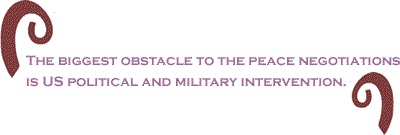
But
it is utterly wrong to say that the Philippines is industrial
capitalist or even semi-industrial capitalist. The Philippines
does not have an industrial foundation. Its floating kind
of industry consists of imported equipment paid for by
the export of raw materials and by foreign loans necessitated
by the chronic trade deficits. It is most precise to describe
the Philippine economy as semi-feudal to denote the persistence
of the large vestiges of feudalism in the form of disguised
and undisguised landlord- tenant relations and usury at
the base of the economy, the peasant class constituting
75 per cent of the population and the combination of the
big compradors and landlords as the main exploiting classes.
The big compradors are the chief financial and trading
agents of the foreign monopolies and are often big landlords
themselves, especially on land producing crops for export.
Global
capitalism under the neoliberal policy of "free trade"
globalization has not changed but has aggravated and deepened
the pre-industrial and underdeveloped semi-feudal character
of the Philippine economy. The share of manufacturing
with the use of imported equipment and raw materials under
the policy of low-value added export-oriented manufacturing
in the last three decades has decreased in comparison
to that share under the previous policy of import substitution.
The illusion of industrial development has been conjured
by excessive foreign borrowing for consumption of foreign
manufactures, by conspicuous private construction projects
and by the sweat shops that engage in the fringe-processing
of imported manufactured components and yield little net
export income.
Neither
the series of bogus land reform programs since decades
ago nor the neoliberal policy of imperialist globalization
has broken up feudalism completely and given way to a
well-founded industrialization. The backward agrarian
and semi-feudal character of the Philippine economy is
now increasingly exposed by its depression and ruination
due to the decreasing demand for its type of exports,
the closure of many sweatshops of semi-manufacturing for
export, the tightening of international credit and the
decrease of remittances by overseas contract workers in
the current prolonged global economic and financial crisis
in this 21st century of desperate, barbaric and imploding
global capitalism. The conditions have become more fertile
for people's war in the Philippines.
In
the 1980s,certain elements in the Philippines pushed the
notion that the Philippine economy was no longer semi-feudal
but semi-capitalist or semi-industrial capitalist in order
to glorify the Marcos fascist dictatorship as having industrialized
the Philippines. This notion also aimed to undercut the
Communist Party's strategic line of protracted people�s
war involving the encirclement of the cities from the
countryside by the armed revolutionary movement of the
workers and peasants until such time that they have accumulated
enough politico-military strength to seize the cities
on a nationwide scale in a strategic offensive.
The
bureaucratic big comprador Ferdinand Marcos conjured the
illusion of industrial development by borrowing heavily
from abroad and by importing consumption goods and luxuries
and construction equipment and structural steel in order
to build roads, bridges, hotels and other tourist facilities.
The profligate spending of foreign loans only served to
maintain the agrarian and pre-industrial character of
the Philippine economy. Cognizant of the persistent semi-feudal
reality, the New People's Army under CPP leadership has
been able to wage people's war successfully with the main
support of the peasantry and under the class leadership
of the working class.
2.
When one talks of the Philippine working class, what are
the main sectors in which it is found and how is neo-liberalism
affecting it?
The
Philippine working class is found in such main sectors
as the following: food and beverages, hotels and restaurants,
public utilities (power generation, water and sewage system),
mining and quarrying, metal fabrication (imported metals),
car assembly, ship assembly, transportation, communications,
mass media, assembly of electronic and electrical products,
chemicals, pharmaceuticals, oil refining, construction,
construction materials (cement and wood), banks and other
financial institutions and public sector services (education,
health, etc.).
In
the Philippines, the neoliberal policy has favored certain
enterprises away from industrial development and has expanded
employment in such enterprises during boom periods. The
favored enterprises include those in mining and export-crop
plantations, the assembly of electronic and electrical
products, the semi-manufacturing of garments, shoes and
other low-value added products for re-export, car assembly,
construction of office and residential towers, cement
production, hotels and restaurants, business call centers
and financial services. They are vulnerable to the ups
and downs characteristic of global capitalism under neoliberal
policy and now to the worst crisis since the Great Depression.
Closures and reduction of production have resulted in
a high rate of unemployment and the further immiseration
of the people.
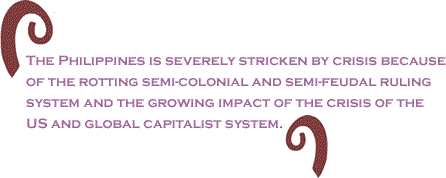
Under
the neoliberal policy, the working class has been subjected
to wage freezes and reductions, loss of job security,
flexibilization or casualization (reducing the number
of regular employees and increasing the number of temporaries
or casuals), systematic prevention or break up of workers'
unions and ceaseless attack on union rights and other
democratic rights. The kinds of enterprises generated
by the neoliberal policy involve cheap labor and the most
tiring and health-damaging processes and conditions. They
also limit the number of regular employees and expand
the ranks of the casuals subjected to a series of short-term
employment contracts in order to circumvent the law on
regular employment. The scarcity of employment opportunities
in the Philippines has compelled nearly 10 per cent of
the population to seek employment abroad as overseas contract
workers and undocumented workers with practically no rights.
This fact proves the lack of national industrial development.
3.
Would you sum-up the situation in the Philippines, particularly
the state of negotiations between the NDFP and the government;
the situation facing workers and farmers; the overall
economy; and fighting that may be taking place?
The
Philippines is severely stricken by crisis because of
the rotting semi-colonial and semi-feudal ruling system
and the growing impact of the crisis of the US and global
capitalist system. The prices of the raw materials and
semi-manufactures produced for export by the Philippines
are depressed and foreign loans to cover the trade deficits
and debt service are becoming more onerous than before.
There is now less demand for overseas contract workers
and thus their remittances are decreasing. The global
economic and financial crisis is hitting hard the Philippines.
The growing public deficits (budgetary and trade) and
the public debt are growing and exposing the bankruptcy
of the big comprador-landlord state.
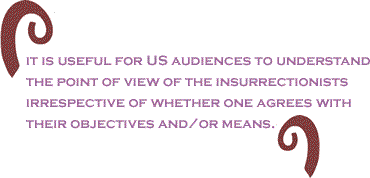
Various
forms of popular resistance, including people�s war, are
ever growing because of the extreme and ever worsening
conditions of exploitation and oppression of more than
90 per cent of the people, the toiling masses of workers
and peasants. Like preceding regimes, the Aquino regime
wants to destroy the armed revolutionary movement. It
is implementing the US-designed Oplan Bayanihan, which
is the same dog as Arroyo's Oplan Bantay Laya but which
tries to be different by dressing up brutal military operations
as peace and development operations and maintaining human
rights desks in the reactionary army and national police
for the purpose of shifting the blame for human rights
violations to the revolutionaries. On the other hand,
the New People's Army led by the Communist Party of the
Party is carrying out a five-year plan to advance from
the strategic defensive to strategic stalemate in the
people's war, increasing the number of guerrilla fronts
from 120 to 180.
While
their respective armed forces continue to fight, the Government
of the Philippines (GPH) and the National Democratic Front
of the Philippines (NDFP) are supposed to engage in peace
negotiations in order to address the roots of the armed
conflict by forging agreements on social, economic and
political reforms. But the GPH has paralyzed the peace
negotiations by refusing to release a few political prisoners
who are NDFP consultants in the negotiations and thus
violating the Joint Agreement on Safety and Immunity Guarantees
(JASIG). The GPH is also grossly violating the Comprehensive
Agreement on Respect for Human Rights and International
Humanitarian Law (CARHRIL) by refusing to release more
than 350 political prisoners who are imprisoned on false
charges of common crimes.
4.
What have been the chief obstacles to a negotiated settlement
between the NDFP and the government?
The
Manila government and NDFP have their respective constitutions,
governments and armies. To lay the ground for peace negotiations,
they issued The Hague Joint Declaration to define the
framework for peace negotiations. They agreed to address
the roots of the armed conflict or the civil war by negotiating
and forging agreements on human rights and international
humanitarian law and on social, economic and political
reforms. They also agreed that they are guided by the
mutually acceptable principles of national sovereignty,
democracy and social justice and that no precondition
shall be made by any side to negate the inherent character
and purpose of peace negotiations, i.e. no side can demand
the surrender of the other side.
Under
the current Aquino r�gime, his presidential adviser and
his negotiating panel want to undermine and nullify the
aforesaid declaration by asserting that it is a document
of perpetual division. They are practically demanding
the immediate surrender of the revolutionary movement.
They do not respect the agreement on the sequence, formation
and operationalization of the reciprocal working committees
that are to negotiate and work out the agreements on reforms.
The question of what kind of authority will be formed
to implement the comprehensive agreements on reforms shall
be settled when the time comes for negotiating the political
and constitutional reforms.
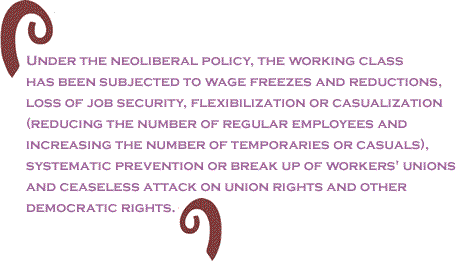
The
Benigno Aquino III regime has shown no respect for and
has in fact violated the Joint Agreement on Safety and
Immunity Guarantees (JASIG) by refusing to release some
14 political prisoners who are NDFP negotiating personnel
and are therefore JASIG-protected. It has not called to
account those military and police personnel who have abducted,
tortured and murdered NDFP consultants who are JASIG-protected.
Also, it has violated the Comprehensive Agreement on Respect
for Human Rights and International Humanitarian Law by
condoning violations of human rights of suspected revolutionaries
and sympathizers by the Arroyo regime and by his own troops
and by refusing to release 350 political prisoners who
are unjustly imprisoned on trumped up charges of common
crimes.
The
regime keeps on demanding ceasefire in order to distract
public attention from the agreement to address the roots
of the civil war though basic reforms. The NDFP has offered
truce and alliance on the basis of a general declaration
on common intent on ten points, including the assertion
of national independence, empowerment of the working people,
land reform and national industrialization, immediate
assistance and employment for the impoverished and unemployed,
promotion of a patriotic, scientific and popular culture,
self-determination of national minorities and independent
foreign policy for peace and development.
The
biggest obstacle to the peace negotiations is US political
and military intervention. The US has upset the peace
negotiations by unjustly designating the CPP, the NPA
and the NDFP chief political consultant as terrorists.
It has dictated upon the Aquino regime to draw up Oplan
Bayanihan under the US Counterinsurgency Guide, which
considers peace negotiations as a mere psy-war2device
for outwitting, isolating and destroying the revolutionary
movement. Oplan Bayanihan is a campaign plan of military
suppression. But it masquerades as a peace and development
plan. It regards peace negotiations only as a means to
enhance the triad of psy-war, intelligence-gathering and
combat operations. Many people think that the US does
not allow the puppet regime to make the overall agreement
for a just and lasting peace with the NDFP.
5.
Are you optimistic that negotiations can result in a just
settlement?
Frankly
speaking, I am not optimistic that negotiations can result
in a just settlement. Like its predecessors, the Aquino
regime is too servile to US imperialism and stands as
the current chief representative of the local exploiting
classes, the comprador big bourgeoisie and landlord class.
It has shown no inclination to assert national independence
and undo unequal treaties, agreements and arrangements
that keep the Philippines semi-colonial. It also has shown
no inclination to realize democracy through significant
representation of workers and peasants in government and
through land reform and national industrialization.
It
has become clear that the reactionary government is not
seriously interested in peace negotiations as a way of
addressing the roots of the armed conflict through agreements
on basic reforms. Especially under the Aquino regime,
the negotiators are always trying to lay aside the substantive
agenda and to push the NDFP towards capitulation and pacification.
Failing to accomplish their vile objective, they paralyze
the peace negotiations by refusing to comply with obligations
under the Joint Agreement on Safety and Immunity Guarantees.
6.
What has been the role of the USA? And, have US policies
towards the Philippines changed under President Obama?
If so, how? What is your overall assessment of the Obama
administration?
The
USA has not been helpful to the peace negotiations. In
fact, it has obstructed these. The US designation of the
Communist Party of the Philippines, New People�s Army
and myself (the National Democratic Front of the Philippines�
chief political consultant) as terrorists is meant to
intimidate and put pressure on the NDFP in the peace negotiations.
The US Counterinsurgency Guide actually tells the Philippine
reactionary government that peace negotiations are dispensable
but are useful only for purposes of psy-war to mislead
the people, possibly split the revolutionary forces and
make the reactionary killing machine more efficient. But
the US policy against peace negotiations with the NDFP
has served to make the revolutionary force and people
more vigilant and more resolute in opposing US intervention
in the internal affairs of the Philippines.
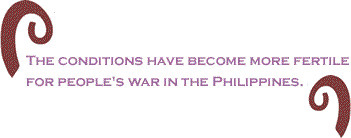
From
the Bush II to the Obama regime, there has been no change
in US policy towards the Philippines. Obama continues
the policy of serving the interests of the US imperialists
in the economic, political, military and cultural fields,
collaborating with the big compradors and landlords, manipulating
the puppet regime and its military forces, preventing
land reform and national industrialization, controlling
the fundamentals and direction of the Philippine cultural
and educational system and stationing US troops in the
Philippines and maintaining a permanent relay of US military
forces under the US-RP3Mutual Defense Pact
and the Visiting Forces Agreement. Obama is a good servant
of US imperialism. He used his glibness to make himself
look better than the brazenly brutal Bush. But he is using
the same glibness to cover many acts as bad as or even
worse than those that made Bush infamous.
7.
How did the CPP and NPA end up on a list of terrorist
organizations? How did you end up on a list of supporters
of terrorism? What steps are being taken to remove this
label from you, the CPP and the NPA?
During
the November 2001 visit of then Philippine president Gloria
M. Arroyo to Washington, she requested then US President
Bush to have the US agencies(State Department and the
Office of Foreign Asset Control of the Treasury Department)designate
the CPP, NPA and myself as "terrorists". When
US state secretary Colin Powell visited the Philippines
in the early days of August 2002, he was reminded of the
request and he assured Arroyo that he would act on it
immediately upon his return to the US. Indeed, within
August 2002 the CPP, NPA and I were designated as "terrorists."
The
Philippine and U.S. governments connived to take advantage
of the terrorism scare that followed 9-11. They themselves
engaged in terrorism by deciding to undertake harmful
actions against the CPP, NPA and myself. The designation
of the CPP and NPA as "terrorist" is absolutely
absurd because they [the NPA - interviewer] have carried
out revolutionary actions strictly within the Philippines,
have not engaged in any cross-border attacks against the
US and up to now have not been discovered to keep bank
accounts in the US or anywhere else outside of the Philippines.

In
my case, I have been falsely accused of being the current
CPP chairman and being responsible for the alleged terrorist
acts, in fact the revolutionary actions, of the NPA despite
the fact that I have been out of the Philippines since
1986 when I was released from nearly a decade of detention
under the Marcos fascist dictatorship. The malicious intention
of the US and Philippine governments is to pressure the
entire NDFP negotiating panel and me as its chief political
consultant. Like the Arroyo regime, the Aquino regime
uses the terrorist designation as a kind of lever against
the NDFP in the peace negotiations.
It
is impossible for the CPP, NPA or myself to begin any
legal process for undoing the terrorist designation in
the US or in any other country tailing after the US in
the so-called war on terror, without proving first the
legal personality and material interest of the plaintiff.
In my case, I could take legal action against the Dutch
government for putting me in the terrorist list because
I live in The Netherlands. After my administrative complaint,
the Dutch government repealed its decision to put me in
its terrorist list but took the initiative in having me
put in the terrorist list of the European Union in October
2002. I went to the European Court of Justice and I succeeded
in having my name removed from the EU terrorist list in
December 2010 after eight years of legal struggle.
8.
Do you think that the US media has consciously mischaracterized
the situation in the Philippines by focusing on groups
like Abu Sayyaf4?
Yes,
the US media drum up US policy and corporate interests
and consciously misrepresent the Philippine situation,
as in the focusing on the Abu Sayyaf. This small bandit
gang, whose origin can be traced to the CIA and intelligence
operatives of the Philippine army who organized and used
it against the Moro revolutionaries (MNLF and then MILF),is
magnified as an extension of Al Qaeda in order to serve
the false claim of [President] Bush that the Philippines
is the second front of a global war on terror as well
as to rationalize state terrorism and US military intervention
in the Philippines.
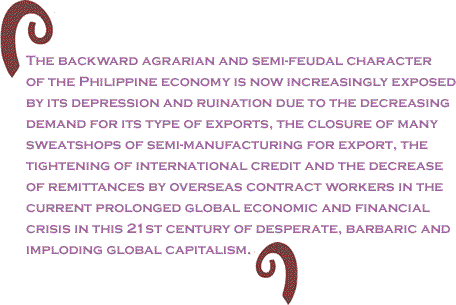
Through
the mass media, the US has spread the scare about terrorism
in order to justify a whole range of actions: the curtailment
of democratic rights in the US and on a global scale,
the stepping up of war production to please the military-industrial
complex and the unleashing of wars of aggression.
9.
Has the "terrorism" designation made it difficult
for NDFP supporters in the Philippines and in other parts
of the world? If so, how? Have civilian political activists
faced increased government-inspired violence as a result
of this terrorism designation?
The
"terrorism" designation is an incitation to
hatred and violence and various forms of discrimination
and harassment against known or suspected NDFP supporters
in the Philippines and other parts of the world. Although
the NDFP is not designated as terrorist, everyone knows
that the CPP and NPA are the most important components
of the NDFP. In the Philippines, the incitation to hatred
and violence is quite deadly because the military, police
and their death squads are emboldened to go on terrorist-hunting
and are assured that they can abduct, torture and kill
people with impunity�
The
Dutch authorities have advised the Norwegian government
not to give any assistance to the NDFP negotiating panel
for maintaining office and staff in The Netherlands on
the claim that such assistance would be for building the
infrastructure of "terrorists". They have also
raided the NDFP office and houses of NDFP panelists and
consultants and seized documents and equipment needed
in the peace negotiations.
10.
Periodically the US media discuss alleged Muslim fundamentalist
terrorism in the Philippines. What is the situation? In
Mindanao there have been efforts at autonomy and self-determination.
What has been the stand of the NDFP on these efforts?
What is your take on allegations of Muslim terrorism?
The
NDFP supports the Moro people's struggle for self-determination,
including the right to secede from an oppressive state
or opt for regional autonomy in a non-oppressive political
system. The Moro people have long been oppressed by the
Manila government and by local reactionary agents. They
are not free in their own homeland and are victims of
Christian chauvinism and discrimination. They have been
deprived of their ancestral domain. They have been robbed
of agricultural land as well as forest, mineral and marine
resources.
The
Moro people have all the right to fight for national and
social liberation. The NDFP has therefore found common
ground for alliance with the Moro National Liberation
Front(MNLF) and subsequently with the Moro Islamic Liberation
Front (MILF) after the MNLF capitulated to the Ramos regime
in 1996. By fighting well against their common enemy,
the NDFP and the MILF gain better conditions for growing
in strength and advancing in their respective struggles.
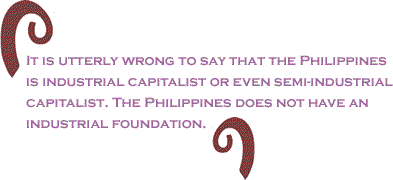
The
US government and the US media exaggerate the threat of
Muslim fundamentalist terrorism because they wish to promote
the entry of US corporations for the purpose of plundering
the rich natural resources of Mindanao, especially oil,
gold and deuterium. They also wish to justify the current
stationing of US military forces and eventually the basing
of larger US military forces for the purpose of strategic
control over Islamic countries in Southeast Asia and strategic
countervailing of China and the Democratic People�s Republic
of Korea [North Korea] in Northeast Asia.
Like
Al Qaeda, Abu Sayyaf was originally a creature of CIA
and the intelligence agency of the Armed Forces of the
Philippines to counteract the MNLF. It has become a bandit
gang since the capitulation of MNLF. It has also been
convenient for the US and Manila government to depict
the Abu Sayyaf as a Muslim fundamentalist group and as
an extension of the Al Qaeda, since 2001 when Bush declared
Moro land as the second front in the so-called global
war on terror. There are indications that the US and Philippine
governments continue to arm and finance the Abu Sayyaf
in order to block the advance of the MILF in Sulu and
to provide the pretext for US military intervention in
the Philippines.
This
commentary was originally published on Alternet.org.
BlackCommentator.com
Editorial Board member, Bill Fletcher,
Jr., is a Senior Scholar with the Institute for Policy Studies, the immediate past president
of TransAfricaForum and co-author of
Solidarity Divided: The Crisis in Organized Labor and a New Path
toward Social Justice (University of California Press), which examines the crisis of organized
labor in the USA. Click here
to contact Mr. Fletcher.

